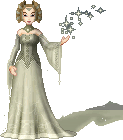 |
 |
|
| 1. Open the base you want to work on. |
2. I haven't included any palettes for this tutorial as the colours you need are very much dependent on how many layers your skirt has & how subtle you want the colour change (if any) to be between layers.
Don't be scared, go choose some colours! |
3. We are going to add each layer onto a new layer. I'll tell you when create a new layer, you get to decide what to call it!
Creare a new above your base by going to Layer/New Raster Layer... or clicking on the new raster layer icon on the Layer Palette. Set your Foreground colour to a dark shade of the colour you want your skirt to be. |
 |
 |
 |
|
4. Make sure your Paintbrush is 1 pixel in size.
Draw in the outline of the top skirt layer. The most important part of this is getting the folds at the bottom right - a nice gentle S curve works well. I find it helps to Zoom in on the image & use precise cursors for this. |
5. Use the Eraser & Paintbrush to tidy up & streamline the outline of the skirt. Ensure that it is not more than 1 pixel thick at all points.
Don't be afraid to take your time on step 4 & 5. A good outline is one of the most important parts of the doll. |
6. Flood Fill the interior of the skirt with a lighter shade.
Each layer is going to be darker than the layer above, but don't worry right now about getting the perfect shade, we can always change it when all layers are complete. |
 |
 |
 |
|
7. Create a new layer under the top skirt layer.
Repeat step's 4, 5 & 6 to add a foldy skirt layer. Make this layer come out slightly more on each side so that we get a nice cascading effect. |
8. Repeat this process to add as many layers as you want, each on it's own layer.
When you get to the bottom layer, don't add as many folds. Flatten any folds you do make to make it look like the skirt is resting on the floor. |
9. If you haven't already done so, re-colour the interior of each skirt layer so that the top layer is the lightest and the bottom the darkest. This can be very subtle. |
 |
 |
 |
|
10. Select a colour slightly lighter than the outline, but not as light as the interior skirts.
On each layer, check any S curves you have used &, if needed, add in the bit of fabric that would be folded under, as shown above. |
11. Now comes the fun bit!
Click on the Lighten/Darken tool. Put a tick in the Swap Mouse Button box. Use the settings from the above link, only set the Width to 1 & Opacity to about 20. Gently, start shading the folds on the top skirt layer. The shading will appear on downward curves. Take your time. The darkening effect builds up with each additional brush stroke, so go carefully, zooming out often to check how it looks. If the shading is too heavy, don't be afraid to drop the Opacity of the brush down a bit more. |
12. Continue in this way down the layers until they are all shaded. |
 |
 |
 |
|
13. .
Take the tick out of the Swap Mouse buttons box. Highlight the "upwards" curve of the folds on each layer. The brighter the highlight (the high the opacity), the shinier the fabric will look. |
14. Put the tick back in the Swap Mouse buttons box.
Using a larger Size (about 4) & an Opacity of about 25, add shading under each layer, on the layer below a shown above. Notice how I extend this shading down the folds on the layer. This is the bit that really makes the layers "pop". |
15. If you want, add some lace to the edge of each layer for a frilly effect. |
 |
||
| Your Skirt is finished! | ||
| << back to tutorials | ||
 dolls
dolls  bases
bases  resources
resources  tutorials
tutorials  contest
contest  links
links  doll maker
doll maker  faq
faq  about
about  forum
forum  guestbook
guestbook

